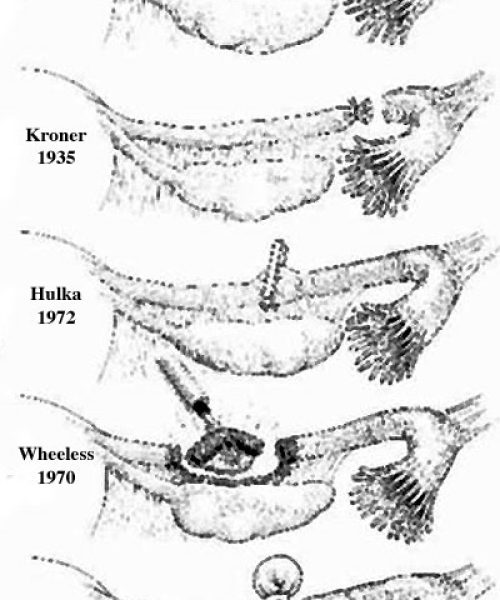© COPYRIGHT 2011-2024 Fertility Center and Applied Genetics of Florida. All Rights Reserved
Tubal Ligation Reversal, Tubal Anastomosis, and Tubal Reversal refer to the same thing. It is the surgical repair of previously obstructed Fallopian tubes. Gynecologic surgeons have many different ways of interrupting Fallopian tubes and the differing techniques are based on the training and skill of the surgeon. In general, higher success after tubal ligation reversal can be expected when there is more length of tube available for repair and when the previous ligation has interrupted the mid-isthmic portion of the tube.
This type of tubal ligation is the most easily reversed. By their design, the clips fit best in the mid-isthmic portion of the tube. This eliminates error in placement. After the microsurgeon removes the clips, the ends of the tubes to be sewn together are of equal diameter. This makes the anastomosis easier. In addition, the isthmic portion of the fallopian tube has a relatively thicker muscular wall than the ampulla. This thicker muscular wall allows a stronger repair.
The fallope ring tubal ligation is also reversible if the surgeon only placed one ring per side. These very strong rubber bands are usually applied in the mid-isthmic portion of the fallopian tube. Since a loop of tube must be brought into the band, this damages more of the isthmic portion of the tube than the clips. Nonetheless, by their design, they are almost always placed in the mid-isthmic portion of the tube. Therefore, when the bands are removed by the microsurgeon, the open ends of the tube available for repair are usually the same diameter and have a substantial muscular wall.
This common type of tubal ligation is also called the post-partum tubal ligation. It is usually done at the time of a Cesarean Section or the day after a normal vaginal delivery. The surgeon usually holds a loop of fallopian tube with special tubal forceps and then makes about a two- to four-centimeter loop of tube that he or she ties with suture. After the loop is tied tightly, the surgeon cuts out the intervening segment of tube. Some surgeons burn the cut ends.
Fortunately, this type of ligation is also quite reversible if the surgeon did not make too large a loop or did not remove the entire ampulla in the process. Most gynecologists will place the loop at the isthmic-ampullary junction and therefore remove a little bit of each portion. This leaves the microsurgeon with the task of anastomosing the isthmic portion of the tube with the ampullary portion of the tube. These parts of the fallopian tube have different diameters and different amounts of supporting muscle wall. The ampulla can at times be paper-thin, requiring the most delicate handling and techniques.
This procedure is usually done through the laparoscope as are the clips and bands. The technique involves holding the fallopian tube between the electrical conducting paddles of a bipolar forceps and turning on the current until enough heat is generated in the tissue (tube), all water evaporates and no more current flows from one paddle through the desiccated tube and into the other paddle. Unfortunately, the heat generated in this process has been shown to spread along the tube for a distance of up to almost one inch (two centimeters) in either direction. In addition, most gynecologists place the paddles two or three times in adjacent portions of the isthmic segment. The damage caused by this type of ligation may be so extensive so that only one or two centimeters of tube are available for repair on either side of the previous cauterization.
This type of tubal ligation can be reversed in most cases, but only if the tube was cauterized in just one spot or if the paddles were applied 2-3 times in very close or adjoining portions of the tube. Oftentimes a patient’s tubes are only 2-3 centimeters in final length after this type of reversal. This leads to lower pregnancy rates after reversal. For that reason, many patients decide to enter into the “in vitro” fertilization program instead. When a patient is treated with “in vitro” fertilization, the clinic actually performs all the functions of the fallopian tube; that is, collection of the egg, fertilization of the egg, culture of the fertilized egg and pre-embryos, and finally transfer into the womb.
This type of tubal interruption is also done through the laparoscope. It involves burning one or more adjoining segments of the fallopian tube and usually cutting them to cause interruption. The heat generated can damage adjoining segments to the tube and lead to very short tubes for anastomosis. Repair can be attempted if the surgery notes indicate that a relatively conservative procedure was performed.
Salpingectomy is the medical term for removal of the tube. Fortunately, some gynecologists use this term to describe a partial salpingectomy and not a total removal of the tube. This type of tubal ligation can be reversed as long as some tube was left near the womb and some portion of the ampulla has been left behind for repair. If there is less than 2 or 3 centimeters remaining for repair, then a reversal is not usually recommended because of a very low chance of success (less than 10%).
The figure below shows a type of tubal sterilization that is not reversible. In top image, the end of the tube is removed. This type of sterilization in rare since the end of the tube is more vascular and presents a higher risk of complications so that most surgeons don’t do this often. This type of distal sterilization is what may be done when the ligation is done through a vaginal incision. This is a older type of procedure that is not frequently done today.
The middle image shows the part of the middle part of the tube being interupted by a clip. These clips can be of the Hulka or Flishley brand.
The lowest image shows the amount of tube usually removed by a Pomeroy type of sterilization.


Your Next Step:
Get your consultation time
by clicking the button below
or by calling 941-342-1568.
© COPYRIGHT 2011-2024 Fertility Center and Applied Genetics of Florida. All Rights Reserved